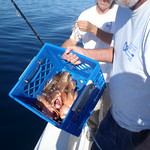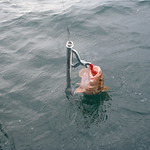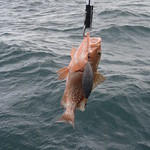Beginning July 15, all recreational, commercial, and for-hire vessels will be required to have a working descending device on-board and readily available when fishing for any of the fish in the snapper-grouper complex in federal waters of the Atlantic Ocean from North Carolina to Florida. In Florida, this means any vessel that is fishing for fish in the snapper-grouper complex (also known as reef fish) in the Atlantic will be required to possess descending gear when fishing greater than 3-miles offshore. This requires a dedicated pole or line with a minimum 16-ounce weighted release tool, or a weighted container, with at least 60 feet of line that is capable of returning fish back to a depth of at least 50 feet.
Why the use of descending devices?
NOAA Fisheries recommends descending devices or venting tools to be used on any fish exhibiting signs of barotrauma. Barotrauma occurs when fish are caught and brought up from deep water, typically greater than 50 feet of depth. The rapid change in pressure when the fish is brought to the surface causes the swim bladder to expand (or even burst). Common signs of barotrauma are the stomach protruding out of the mouth, bulging eyes, and distended intestines. Descending devices use a weight to return the fish to depth, which recompresses the expanded gas and reverses the effects of barotrauma. Science has shown that descending gear is very effective at getting fish back down to depth, and this increases survival rates by minimizing the effects of barotrauma.


 Reef fish like snapper and grouper are the most susceptible species to barotrauma because they live on the bottom. The snapper-grouper complex includes a large list of fish, including snappers, groupers, and popular food fish like amberjack, black seabass, spadefish, and tilefish. Considering that more than 60% of recreational fish are caught and released, use of descending gear can increase the number of fish that survive to be caught again at a larger size or later when in-season. Fisheries research conducted in collaboration with fishers shows that using descending tools greatly increases survival rates. Another advantage is descending gear reduces predators that feed on “floaters,” or released fish floating on the surface. These impaired fish are often eaten by birds, dolphins, and sharks as they struggle to return to deeper water.
Reef fish like snapper and grouper are the most susceptible species to barotrauma because they live on the bottom. The snapper-grouper complex includes a large list of fish, including snappers, groupers, and popular food fish like amberjack, black seabass, spadefish, and tilefish. Considering that more than 60% of recreational fish are caught and released, use of descending gear can increase the number of fish that survive to be caught again at a larger size or later when in-season. Fisheries research conducted in collaboration with fishers shows that using descending tools greatly increases survival rates. Another advantage is descending gear reduces predators that feed on “floaters,” or released fish floating on the surface. These impaired fish are often eaten by birds, dolphins, and sharks as they struggle to return to deeper water.
For more information
For more information on how to identify barotrauma and select and use descending gear, please visit the Florida Sea Grant Catch and Release website or call the UF/IFAS Brevard County Extension at 321-633-1702. Please see the complete Fishery Bulletin issued from NOAA Fisheries for additional information and details including a list of Frequently Asked Questions.
Original blog post authored and published by Shelly Krueger, Florida Sea Grant agent at the University of Florida IFAS Extension in Monroe County. This blog post modified and published by Holly Abeels, Florida Sea Grant agent at the University of Florida IFAS Extension in Brevard County.
 0
0

Comments are closed.